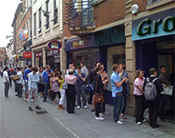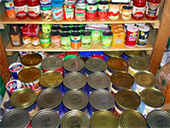
Opposed to what people think food crisis are very common. In fact there are countries and regions which are going through one right now. The United Nations Food and Agriculture Organization estimates that nearly 870 million people, or one in eight, were suffering from chronic undernourishment in 2016-2020. Almost all the hungry people, 852 million, live in developing countries. But there are 16 million people undernourished in developed countries including US.
My guess is none of you experienced a long time hunger. But probably most of you are familiar with the feeling of skipping 3 or 4 meals. Not a very pleasant one. During that time did you experience fatigue or dizziness? These are the first general symptoms of malnutrition. If you don’t eat for days, your condition will get worse and you start losing weight. Your body will consume first the fat reserves, than your protein (muscles). If untreated, starvation may lead to mental or physical disability, illness, and possibly death. An average man cannot survive without food for more than 8 weeks. A food crisis may last for months or years. And it’s not enough to stockpile food In order to properly prepare yourself and your family. Take into consideration that you may develop malnutrition if you lack a single vitamin in the diet. This is why it’s very important to start preparing after having read a proper guide.
What creates food crises?
There are many reasons why people cannot grow or buy enough food to feed their families. Most of the reasons causing a food crisis are a combination of the issues below. A hunger crisis develops when families experience these factors for a long time and run out of ways to cope.
POVERTY
The main reason why most people are unable to feed themselves is that they cannot afford it. And this is exactly the issue in many poor countries. You may think poverty cannot be an important factor in the US, but in a major economic SHTF event things could start to get out of hand. When economy collapses the food will become scarce, like the North Korean famine 1994-1998.
U.S. Economy since 9/11
For example the 9/11 attacks had both immediate and long-term economic impacts. The attacks caused the Dow to drop more than 600 points and led to one of the biggest government spending programs in U.S. history – the War on Terror. Now think about the US spendings in case of a real threatening war or maybe a world war. In the First World War Germany capitulated because of its economic collapse. Families were actually starving back home: 763,000 German civilians died from starvation and disease caused by the Allied blockade. This is only an example, but there are hundreds of similar scenarios.
NATURAL DISASTERS
Drought, flooding, hurricanes, tsunamis and earthquakes can disrupt the commercial means of alimentation. You might have all the money in the world but no food to buy. Remember when Hurricane Katrina hit in 2005, a lot of stranded people in New Orleans endured hunger, little water and limited emergency supplies for days. What happened during Katrina could also happen on a wider scale. Climate change is having an increased impact on food production as droughts and flooding become more frequent and more severe. Natural disasters are very real and very likely to happen even more than once in a lifetime. When it strikes will you be prepared? It very well can happen tomorrow. And could last for four years like the Tempo Famine in Japan.
CONFLICTS
Food crisis are very often associated with conflicts. War makes delivery of food much more difficult, particularly if aid workers are attacked and supplies are looted. Conflict can drive people from their homes and away from their normal food supply, leave them unable to afford food or simply stop them planting. The deadliest war in modern African history had killed 5.4 million people, mostly from disease and starvation, making the Second Congo Warthe deadliest conflict worldwide since World War II. Even after the war had ended, 1,000 people died daily in 2004 from malnutrition and disease.
DISEASE
Food shortages are also often associated with widespread epidemics. Disease outbreaks such as the 2005 Ebola-like Marburg virus in Angola put pressure on food supplies as deliveries ceased due to drivers staying away. If a new deadly virus hits the USA, I doubt people will be confortable leaving their homes. And rightly getting in touch with as few people as possible may save your life. If you have stockpiled food, of if you have the means to produce it, then there’s no need to worry.
Of course there are other factors that may start a food crisis. For example the famine in Ukraine – a man-made famine in 1932 and 1933 that killed up to 7.5 million Ukrainians. There are 127 recorded great famines and almost at any given historical period there was a food crisis somewhere in the world.
How to be prepared for a food crisis?

In case of a food shortage you should be aware that grocery stores only have about 3 days of food in stock. People will rush and buy as much as they can so probably the food will vanish in less than a day or hours. So if anything was to disrupt the food supply chain for an extended period of time, there would be chaos in most communities. It’s very important to start preparing NOW. There are several ways to start. The choice you make should depend on the event you are preparing for. Of course the best way is to prepare for all scenarios including long periods.
Food Crisis queueIn case of a food shortage you should be aware that grocery stores only have about 3 days of food in stock. People will rush and buy as much as they can so probably the food will vanish in less than a day or hours. So if anything was to disrupt the food supply chain for an extended period of time, there would be chaos in most communities. It’s very important to start preparing NOW. There are several ways to start. The choice you make should depend on the event you are preparing for. Of course the best way is to prepare for all scenarios including long periods.
1. Stockpiling Food
You should see your Food Bank as an investment. My advice is to buy food that you actually like to eat. So in case a major SHTF event will not hit until the expiration date of your food, then you can eat it (without spending additional money on food) and then renew your stock.
Another issue is where and how to properly stockpile food. You may need to create some space to keep the extra food, both frozen, and dry/canned goods. This may mean purchasing an extra freezer, or some closed storage shelves. If you have a panic room or maybe a basement you can start stockpiling there. Check storing advices (temperature, humidity, etc.) on the packages and see if it matches with your stockpiling room. Remember you should easily access this room and very few people should know about it.
Decide what food you want to store and how much. This depends on the food crisis period you want to be prepared for and of course the budget you plan to invest.

You can find bellow some items easy to stock because they have lengthy expiration dates, so you can stash them away for long periods of time. Make a list of everything you actually like and take into consideration that your stock has all the vitamins, carbohydrates, minerals, fats and protein. In a food crisis the most important food is the one with most carbohydrates which are the main fuel for physical energy. So keep in mind that having at least on item like rice, pasta, cereals is almost mandatory.
Before stocking other items take into consideration:
Bottled water: If a person can live without food for more than a month, without water it’s unlikely to survive more than 4 days; a normally active person should drink at least a half-gallon of water each day;
Salt: One of the most useful items. It’s used for storing food, curing beef, and flavoring most meals. Salt will stay forever!
Supplements: Multivitamins and minerals will help replace the nutrients you would have consumed on a normal diet;
Peanut Butter: Peanut butter is a source of protein, fat, and calories; can last up to five years;
Fish: essential fatty acids to keep your immune system strong. Also contains vitamin D. Try storing dried fish, canned or frozen fish;
Powdered milk: contain all twenty-one standard amino acids, and are high in vitamins and minerals. The typical average amounts of major nutrients are 36% protein, 52% carbohydrates, calcium 1.3%, and potassium 1.8%. One of the best items to get your calcium from; if stored properly can last for more than 2 years;
Carbohydrates
Rice: If kept properly rice may stay in good condition for 10 years or more; there are a lot of dishes you can do with rice;
Pasta: Stores extremely well and like rice can you can make a lot of dishes;
Flour and whole grains: Grains are the cheapest items one can buy on a per-pound basis. If you have the means to grind than you should stock whole grain because it preserves better;
Nuts and trail mixes: high-energy foods, healthful and convenient for snacking.
Protein
Beans: High in protein, and if stored properly can stay for up to ten years. Make sure to store them in a cool, dry, dark location.
Canned Meat: typically will keep for 6-10 years and they’re an excellent source of protein. If the grid is down for a long time it’s very important to have this item because excessive hunting and fishing may extinct some species;
Vitamins
Canned Fruit & Vegetables: Not a very good source of calories and it takes a lot of space to store but the best natural source of vitamins;
Dried fruits, such as apricots and raisins: potassium and dietary fiber; really easy to store;
Fat
Lard: offer much-needed calories during times of crisis, cooking oil for multiple uses, and it will keep longer than cooking oils because of the hydrogenation;
Sugars
Honey: is also excellent as it will store forever. Mostly made from sugars and contains only trace amounts of vitamins, minerals and antioxidants;
These are just some good examples but you may find here the nutrients of almost all types of food.
2. Produce Your Own Food
Although it’s very important to stock food, on a long term food crisis can be wiser to have the means to produce your own food. If you live in a city and you don’t have a backyard, you should take into consideration buying at least one acre somewhere in the countryside. Most famine victims are townspeople. Living in the countryside makes it much easier to procure your food. If you don’t know much about gardening, then start small with a few garden boxes for tomatoes, herbs, or sprouting. And also you can raise animals. Choose only domestic animals that can provide you with more than meet: chickens or ducks for eggs, cows or sheep for milk, fishes for fish eggs. Just like stockpiling food think that you should get all vitamins, carbohydrates, protein, fats, and minerals.
Remember that you may need to:
– Protect Your Harvest against looters: visibly mark your land and if you have the means try building a fenced yard; looters will know that your land it’s better defended so it’s likely to try stealing from someone else; always keep a gun by your side;
– Learn Food Preservation: maybe you need to store food for the winter or maybe you want to have a food reserve just in case. Food preservation comes in many forms such as canning, pickling, and dehydrating. Some tools and materials are required along with a good deal of knowledge. Also build a basement to better stock your food;
– Store Seeds: save some of the harvest to collect the seeds and to plant them the next year. Collect your seeds from the healthiest plants. Also learn how to properly store and plant them;
– Trade Food in order to supply with other materials you can’t procure otherwise;
One of the best ways to produce your food in a SHTF situation is to build an aquaponics system. Aquaponics combines hydroponics and aquaculture into one symbiotic system consisting of plants and aquatic organisms. Practically an Aquaponic System it’s a self-sustained bio system where the fish excrements are broken down by nitrogen-fixing bacteria into nitrates and nitrites which are utilized by the plants as nutrients. The water is then recirculates back to the aquaculture system. It’s a win, win, win for the plants, the fish and for you.
I’d rather choose aquaponics in a food crisis or major SHTF situation because:
– It can provide you with almost any type of vegetables/fruits and fish; you’ll have all your protein, vitamins, calories and good fats; you’ll also have fish eggs;
– Aquaponics saves water; in case of a drought or in a SHTF when water may become scarce keep in mind that your plant will not be affected; aquaponics uses 90% less water than soil based agriculture because the water recirculates within the system rather than seeps away;
– You’ll always have a surplus of water for you and your family to drink;
– Plants grow faster. Because we are continually bringing fresh nutrient to the plants they grow faster; you’ll find that plants growing faster means you need half the space than in soil based gardening;
– can be adapted for small spaces; In urban environments where space is a valuable commodity, it can come in all shapes and sizes;
You may consider aquaponics not only for a food crisis but also as a mean to produce healthy, fresh food for your family.
More so, Dr. Nate Storey, a Ph.D at University of Wyoming in Agronomy, inventor and CEO at Bright Agrotech has recently increased aquaponic production using zipgrow towers. You can now grow 3 times more vegetables using this vertical planting method.
The flexibility of creating your own farm is part of what makes this method so popular. Systems can range from small backyard setups to vast commercial systems that fill up entire rooms. You can use fresh water or salt water. You can choose different types of fish and plants as well.
Want to know more about the threats we face to our food system and what you can do about it? Read Why you need to have a SHTF/emergency food supply plan.
Books can be your best pre-collapse investment.
Carnivore’s Bible (is a wellknown meat processor providing custom meat processing services locally andacross the state of Montana and more. Whether your needs are for domestic meator wild game meat processing)
The Lost Book of Remedies PDF ( contains a series of medicinal andherbal recipes to make home made remedies from medicinal plants and herbs.Chromic diseases and maladies can be overcome by taking the remediesoutlined in this book. The writer claims that his grandfather was taughtherbalism and healing whilst in active service during world war twoand that he has treated many soldiers with his home made cures. )
Easy Cellar(Info about building and managing your root cellar, plus printable plans. The book on building and using root cellars – The Complete Root Cellar Book.)
The Lost Ways (Learn the long forgotten secrets that helped our forefathers survive famines,wars,economic crisis and anything else life threw at them)
LOST WAYS 2 ( Wordof the day: Prepare! And do it the old fashion way, like our fore-fathers did it and succeed longbefore us,because what lies ahead of us will require all the help we can get. Watch this video and learn the 3 skills that ensured our ancestors survival in hard times offamine and war.)
Survival MD (Best Post Collapse First Aid Survival Guide Ever)
Conquering the coming collapse (Financial advice and preparedness )
Liberty Generator (Build and make your own energy source)
Backyard Liberty (Easy and cheap DIY Aquaponic system to grow your organic and living food bank)
Bullet Proof Home (A Prepper’s Guide in Safeguarding a Home )
Family Self Defense (Best Self Defense Strategies For You And Your Family)
Survive Any Crisis (Best Items To Hoard For A Long Term Crisis)
Survive The End Days(Biggest Cover Up Of Our President)
Drought USA(Discover The Amazing Device That Turns Air Into Water)
SOURCE : graywolfsurvival.com



